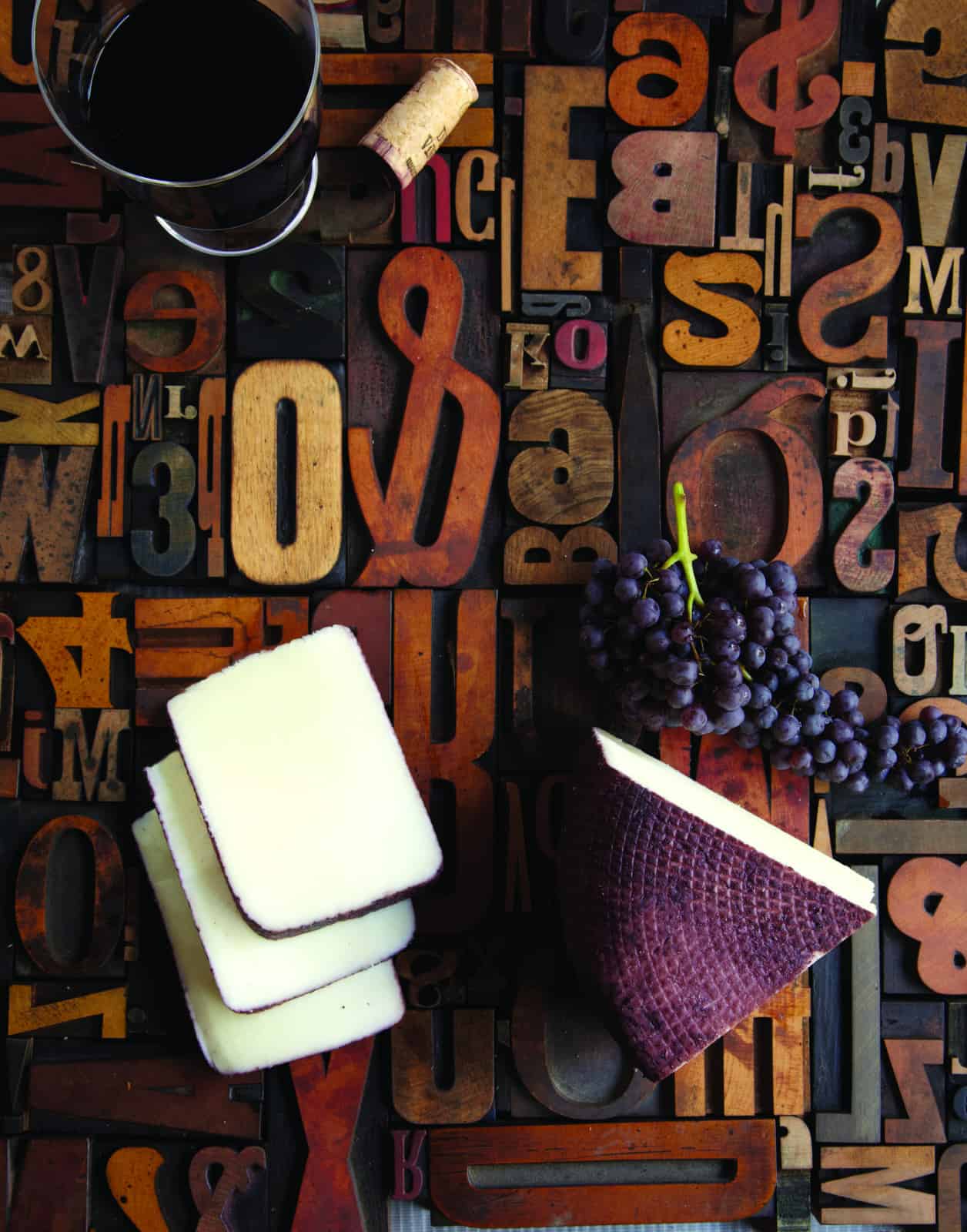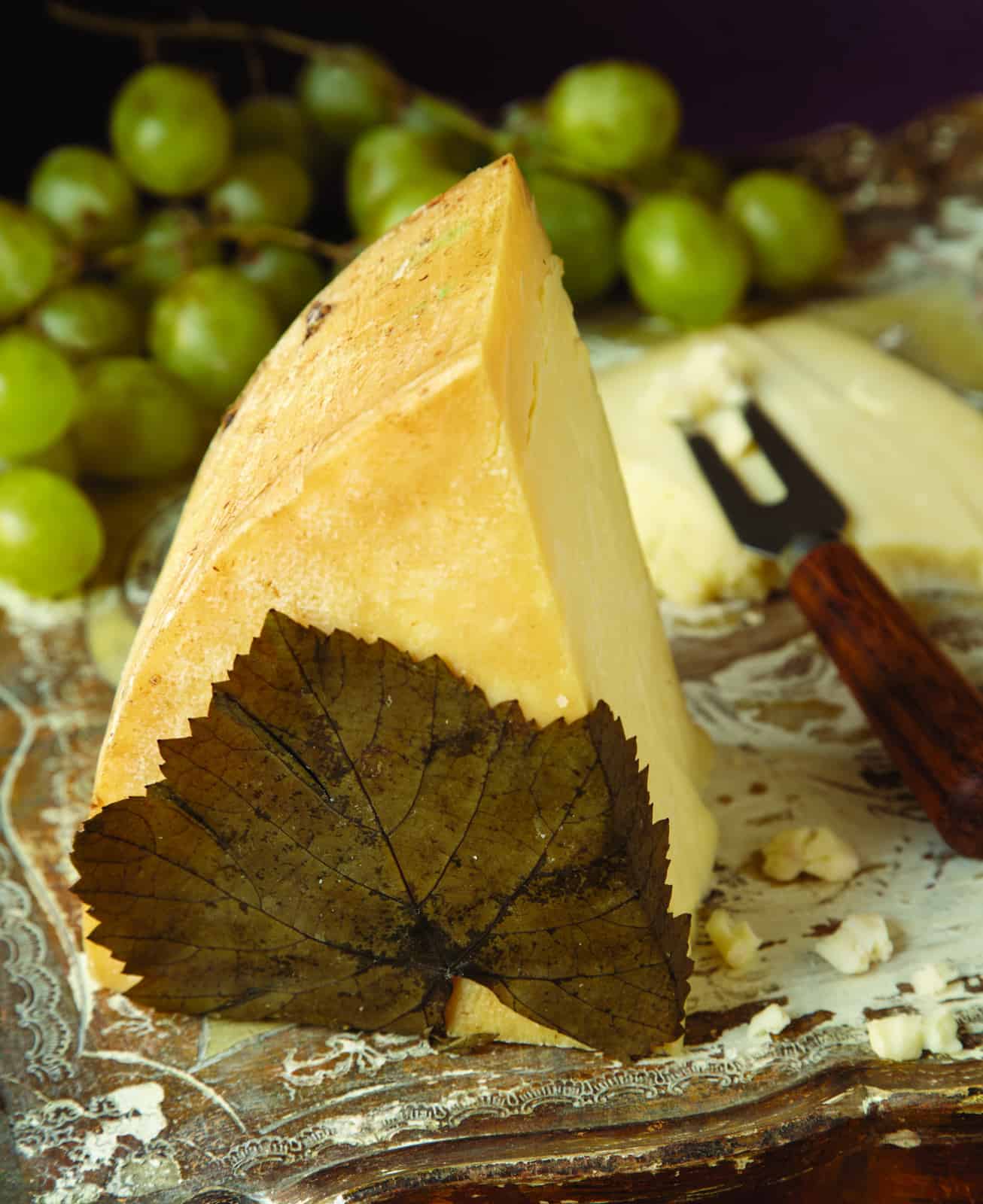
Do you remember the cheese ball? It was a staple party snack circa 1976. All it took was an array of cheeses and a few splashes of sweet red wine, mashed together with the back of a fork. The mass held together well but still retained distinguishable purple streaks. The aromas that emerged were intoxicating: fruity, sharp, and cheesy.
It’s an American take on an age-old European tradition. In its earliest permutations, mixing wine and cheese was likely a convenient way to use leftovers: One made wine to preserve the glut of grapes that ripened in autumn, and cheese extended the life of milk from one’s animals. Sometimes, perhaps, a cheese needed help in the flavor department, so in went a splash of wine. Or wine might be used to break up the bacterial partygoing on—to dampen their enthusiasm with alcohol—thus keeping the cheese safe for consumption a while longer.
The combination of super-ripe cheese and wine is essentially what the French call fromage fort, the brawny, hairy-chested godfather of the American port-hued cheeseball. But there are other, more elegant ways of incorporating wine and cheese. Swiss cheesemaker Seiler Käserei adds white wine to cow’s milk when making its raclette. “When it’s melted, it immediately starts smelling like a fondue,” says Caroline Hostettler of importing company Quality Cheese. The raclette is best eaten when fairly young—before nine months—while the paste is still mild and the wine flavor is fruity and bright.

Tome d’Aquitaine (top) and Raclette Mit Weisswein
A more typical approach to creating a vinous cheese is to apply wine to the outside of a wheel. The process yields a comparative gentleness of funk, bringing to mind classic French rounds, like Jean d’Alos’ Tomme d’Aquitaine, a goat cheese washed in dry Muscadet and sweet Sauternes, which give its ivory paste a delicate, floral fruitiness. Or Tomme Fermier d’Alsace, a golden cow’s milk wheel with an almost cheddar-like flavor and baked pear overtones from its wash in local white wines.
Wine-washing is common in Italy as well: Prosecco Ubriaco is one of the most overtly winey examples. Its mild, buttery paste is redolent of floral green grape notes of prosecco, the grape that makes Italy’s most popular sparkling wines. At Sartori in Plymouth, Wisconsin, cheesemakers take an even more common approach. To make Merlot BellaVitano Reserve, 20-pound cow’s-milk rounds of flagship BellaVitano are brined and cured before being moved into tanks of merlot for an extended wine bath. After a few days of regular turning, the wheels are removed gorgeously purple and exuding a fruity wine scent.
If there’s one cheese that begs for a thorough dousing in wine, however, it’s blue. Port wine aficionados have been known to jam an open bottle into a wheel of Stilton, letting the wine drain slowly into the round. Antonio Carpenedo, who runs La Casearia Carpenedo in the small northeastern Italian town of Povegliano, created Blu ’61 for his wife in honor of their 50th wedding anniversary. A lightly blued cow’s milk cheese, Blu ’61 is bathed in Passito di Raboso, a sweet local wine made from partially dried red grapes, and topped with wine-soaked cranberries. Intensely smooth and overtly berried, it’s a wonderful dessert all on its own: a play of sweetness, tang, earth, and fruit that encompasses all that is good about cheese and wine in one complex mouthful.

Pride of Bacchus
Tasting Notes
Ubriaco al Prosecco
Latteria Moro
Oderzo, Italy
Ubriaco is Italy’s traditional “drunken” cheese, particularly popular in the north, where the lack of olive oil inspired cheesemakers to preserve wheels in wine instead. Sergio Moro’s version, washed in prosecco, is a firm cow’s milk cheese infused with the delicate floral notes and green-grape flavor of the wine
Raclette Mit Weisswein
Seiler Käserei
Sarnen, Switzerland
At Seiler Käserei in Switzerland, makers blend white wine directly into cow’s milk to create this semi-firm cheese. The raclette comes into its own when heated; it’s indispensable to the traditional Swiss dish of the same name.

Ubriaco al Prosecco
Tome d’Aquitaine
Jean d’Alos
Bordeaux, France
Washed in dry Muscadet and finished with sweet Sauternes in the cave, this goat cheese is mild and firm with a lightly floral fruitiness imbued in dense, ivory paste.
Drunken Goat
Mitica
Murcia, Spain
The first Queso de Murcia al Vino DOP to be imported to the US, this cheese is made from the milk of the local Murcian goat. It’s cured in Doble Pasta red wine and aged up to 75 days, yielding a semisoft paste with a smooth flavor. The taste of the wine is most prominent near the violet rind.
Merlot BellaVitano
Sartori Cheese
Plymouth, Wisconsin
Sartori’s Master Cheesemakers soak prizewinning BellaVitano Gold in merlot to dye the rind a deep purple and infuse the paste—a cheddar-Parmesan hybrid—with winey complexity.
Blu ’61
La Casearia Carpenedo
Camalo di Povegliano, Italy
Antonio Carpenedo, of his family creamery in Italy’s Veneto region, created this very creamy cow’s milk blue doused in Passito di Raboso, a sweet, local red wine. Bedecked with wine-soaked cranberries, it’s intensely hedonistic and ready to take the place of dessert.




